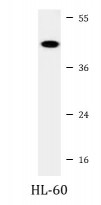ARG55135
anti-ADA antibody
anti-ADA antibody for Flow cytometry,Western blot and Human
Cancer antibody; Gene Regulation antibody; Metabolism antibody
Overview
| Product Description | Rabbit Polyclonal antibody recognizes ADA |
|---|---|
| Tested Reactivity | Hu |
| Tested Application | FACS, WB |
| Host | Rabbit |
| Clonality | Polyclonal |
| Isotype | IgG |
| Target Name | ADA |
| Antigen Species | Human |
| Immunogen | KLH-conjugated synthetic peptide corresponding to aa. 287-314 (C-terminus) of Human ADA. |
| Conjugation | Un-conjugated |
| Alternate Names | Adenosine deaminase; EC 3.5.4.4; Adenosine aminohydrolase |
Application Instructions
| Application Suggestion |
|
||||||
|---|---|---|---|---|---|---|---|
| Application Note | * The dilutions indicate recommended starting dilutions and the optimal dilutions or concentrations should be determined by the scientist. | ||||||
| Positive Control | HL-60 |
Properties
| Form | Liquid |
|---|---|
| Purification | Purification with Protein A and immunogen peptide. |
| Buffer | PBS and 0.09% (W/V) Sodium azide |
| Preservative | 0.09% (W/V) Sodium azide |
| Storage Instruction | For continuous use, store undiluted antibody at 2-8°C for up to a week. For long-term storage, aliquot and store at -20°C or below. Storage in frost free freezers is not recommended. Avoid repeated freeze/thaw cycles. Suggest spin the vial prior to opening. The antibody solution should be gently mixed before use. |
| Note | For laboratory research only, not for drug, diagnostic or other use. |
Bioinformation
| Database Links | |
|---|---|
| Gene Symbol | ADA |
| Gene Full Name | adenosine deaminase |
| Background | This gene encodes an enzyme that catalyzes the hydrolysis of adenosine to inosine. Various mutations have been described for this gene and have been linked to human diseases. Deficiency in this enzyme causes a form of severe combined immunodeficiency disease (SCID), in which there is dysfunction of both B and T lymphocytes with impaired cellular immunity and decreased production of immunoglobulins, whereas elevated levels of this enzyme have been associated with congenital hemolytic anemia. [provided by RefSeq, Jul 2008] |
| Function | Catalyzes the hydrolytic deamination of adenosine and 2-deoxyadenosine. Plays an important role in purine metabolism and in adenosine homeostasis. Modulates signaling by extracellular adenosine, and so contributes indirectly to cellular signaling events. Acts as a positive regulator of T-cell coactivation, by binding DPP4. Its interaction with DPP4 regulates lymphocyte-epithelial cell adhesion. [UniProt] |
| Cellular Localization | Cell membrane; Peripheral membrane protein; Extracellular side. Cell junction. Cytoplasmic vesicle lumen. Cytoplasm. Note=Colocalized with DPP4 at the cell junction in lymphocyte-epithelial cell adhesion |
| Research Area | Cancer antibody; Gene Regulation antibody; Metabolism antibody |
| Calculated MW | 41 kDa |
Images (2) Click the Picture to Zoom In
-
ARG55135 anti-ADA antibody WB image
Western blot: 35 µg of HL-60 cell lysate stained with ARG55135 anti-ADA antibody.
-
ARG55135 anti-ADA antibody FACS image
Flow Cytometry: HL-60 cells stained with ARG55135 anti-ADA antibody (right histogram) or without primary antibody control (left histogram), followed by incubation with FITC labelled secondary antibody.







